Mini-trampolines offer gentle, joint-friendly exercise that’s perfect for beginners. Start with feet shoulder-width apart and simply march in place for 5-10 minutes, keeping your knees slightly bent. Focus on controlled movements and proper breathing—inhale as you land and exhale as you rise. Wear supportive shoes and always engage your core for stability. Listen to your body and gradually increase duration as your comfort improves. The following techniques will transform your rebounding experience.
Why Mini-Trampolines Offer Relief for Fibromyalgia Symptoms
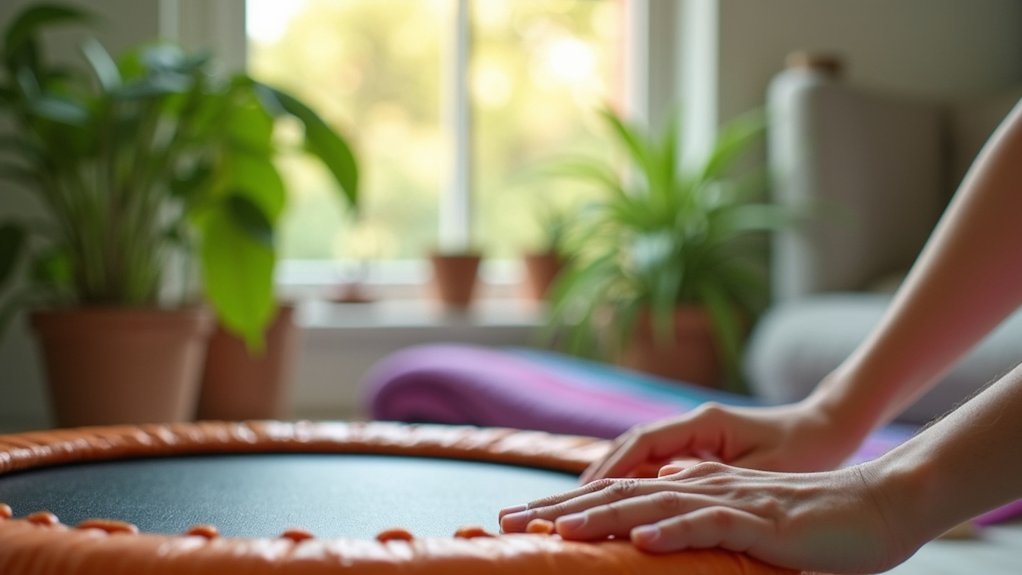
When living with fibromyalgia, finding suitable exercise options can feel overwhelming as traditional high-impact workouts often exacerbate pain rather than relieve it. This is where mini trampolines shine as an exceptional alternative. The gentle bouncing motion provides cardiovascular benefits without jarring your sensitive joints.
The rhythmic rebounding movement stimulates your lymphatic health, promoting natural detoxification that may reduce fatigue and muscle stiffness common with fibromyalgia. You’ll likely notice improved circulation and oxygen delivery to your muscles, potentially decreasing pain intensity while boosting your energy levels.
Beyond physical benefits, rebounding often triggers endorphin release, helping combat the depression and anxiety that frequently accompany fibromyalgia. The playful nature of bouncing can make exercise enjoyable again, encouraging you to maintain activity despite challenging symptoms.
Getting Started: Basic Bouncing Techniques for Pain Management
Starting your mini-trampoline journey begins with gentle bounce fundamentals that keep both feet on the surface while slightly bending your knees to absorb shock.
Position yourself in the center of the trampoline with feet hip-width apart to maintain balance and stability while engaging your core muscles.
You’ll benefit from impact-free rebound techniques by starting with 5-10 minute sessions and incorporating gentle arm movements that enhance circulation without straining your body.
Gentle Bounce Fundamentals
Before diving into complex exercises, mastering the gentle bounce on your mini-trampoline creates a foundation for effective pain management. Stand with your feet shoulder-width apart and begin by allowing your body to bounce gently without lifting your feet from the surface. This minimizes joint impact while still activating muscles.
Keep your core engaged throughout each movement to enhance stability and balance. This engagement naturally improves your posture and reduces discomfort as you exercise. Maintain a relaxed upper body, letting your arms swing naturally or rest at your sides to prevent shoulder tension.
Start with just 5-10 minutes of gentle bouncing, gradually extending your sessions as comfort improves. Focus on landing softly, utilizing the trampoline’s shock-absorbing properties to cushion movements and manage joint pain effectively.
Balance-Focused Starting Positions
Since establishing good balance creates the foundation for any effective rebounding workout, you’ll want to master several key starting positions before advancing to more complex exercises.
Begin with feet shoulder-width apart, engaging your core muscles to maintain stability while gently bouncing. As you gain confidence, practice shifting your weight from foot to foot, which enhances balance and stability during your low-intensity workout.
Keep your knees slightly bent to protect joints while practicing basic bounces. For additional support, don’t hesitate to use a stability bar or hold the rebounder’s edges, especially if managing pain.
Incorporate your upper body by swinging arms naturally or extending them overhead to improve coordination. These foundational positions guarantee safe rebounding while building the confidence needed for more advanced techniques.
Impact-Free Rebound Techniques
While traditional exercises often strain joints and aggravate pain, mini-trampoline rebounding offers a genuinely impact-free alternative that cushions movement through its elastic surface.
Begin with gentle bouncing or walking in place, allowing your body to adapt to the trampoline’s forgiving surface. Focus on movements that are gentle on your joints by keeping your bounces controlled and light. Engage your core muscles throughout each exercise to improve stability and protect your spine.
Incorporate low-impact movements like side-to-side shifts and small knee lifts to stimulate lymphatic circulation without discomfort. Start with brief 10-15 minute sessions, gradually extending your workout time as comfort increases.
Remember to maintain proper posture and listen to your body—the goal is fluid, pain-free movement that supports healing rather than causing additional strain.
Low-Impact Rebounding Routines for Joint Protection
When protecting your joints during mini-trampoline workouts, focus on cushioned bounce techniques that allow your body to sink slightly into the mat before gently pushing upward.
Incorporate fluid shifts between movements, avoiding jerky or abrupt changes that might strain vulnerable joints.
You’ll find greater stability and joint protection by maintaining supported standing movements, keeping your knees slightly bent and using the trampoline’s frame for balance when needed.
Cushioned Bounce Techniques
Many fitness enthusiasts with joint concerns can benefit from cushioned bounce techniques on mini-trampolines. When you step onto a mini-trampoline, the flexible surface absorbs shock that would otherwise impact your knees, hips, and lower back. This makes low-impact rebounding an ideal exercise option if you’re managing joint pain or mobility issues.
- Feel the freedom of gentle bouncing without the jarring impact you’d experience on hard surfaces.
- Experience the confidence that comes as you improve balance and coordination with each controlled movement.
- Enjoy the satisfaction of effectively working your core and lower body muscles while protecting your joints.
Maintain controlled movements during your trampoline sessions to enhance stability and promote lymphatic flow, contributing to your joint health while still getting an effective workout.
Gentle Fluid Transitions
Shifting smoothly between movements on your mini-trampoline creates an effective low-impact workout that protects vulnerable joints. Your trampoline’s shock-absorbing surface enables gentle bouncing while maintaining cardiovascular benefits and muscle engagement.
| Movement | Benefit | Shift Tip |
|---|---|---|
| Walking in place | Improves balance | Gradually increase knee lift |
| Weight shift jumps | Enhances core strength | Flow into arm movements |
| Gentle marching | Boosts lymphatic flow | Add arm swings progressively |
When creating low-impact rebounding routines, focus on continuous motion. Start with basic bouncing, then shift to jumping jacks with feet before adding arm movements. This flow keeps your heart rate up without jarring your body. You’ll enjoy effective workouts while minimizing joint strain—perfect for those with injuries or joint concerns.
Supported Standing Movements
Five supported standing movements transform mini-trampoline workouts into accessible exercises for anyone with joint concerns.
By holding onto the stability bar during low-impact rebounding, you’ll protect your joints while still enjoying cardiovascular benefits. These movements are perfect for seniors, beginners, or those recovering from injuries.
- Gentle side-to-side steps – Feel your confidence grow as you safely shift weight without jarring your knees.
- Supported knee lifts – Experience freedom of movement without fear of falling.
- Resistance band exercises – Build strength while your body enjoys the cushioned surface.
These supported standing movements improve balance and coordination notably, helping prevent falls and enhancing functional fitness.
You’ll gain stability and mobility simultaneously—all while placing minimal stress on your joints.
Proper Form and Safety Considerations for Sensitive Bodies
When approaching mini-trampoline exercises with a sensitive body, proper form becomes your greatest ally in preventing injury while maximizing benefits.
Maintain a stable stance with feet hip-width apart and knees slightly bent to create a solid foundation. This proper form reduces fall risks while enabling gentle bouncing that’s kind to your joints.
Always engage your core muscles throughout your workout to protect your spine and enhance stability.
For safety considerations, wear athletic shoes with good grip to prevent slipping, and start with low-intensity movements like walking in place before attempting more dynamic exercises.
Remember to listen to your body carefully—it’s your best guide.
Take breaks whenever you feel discomfort or fatigue, as pushing through pain can lead to injury rather than progress.
Gradually Building Endurance Without Triggering Flare-Ups
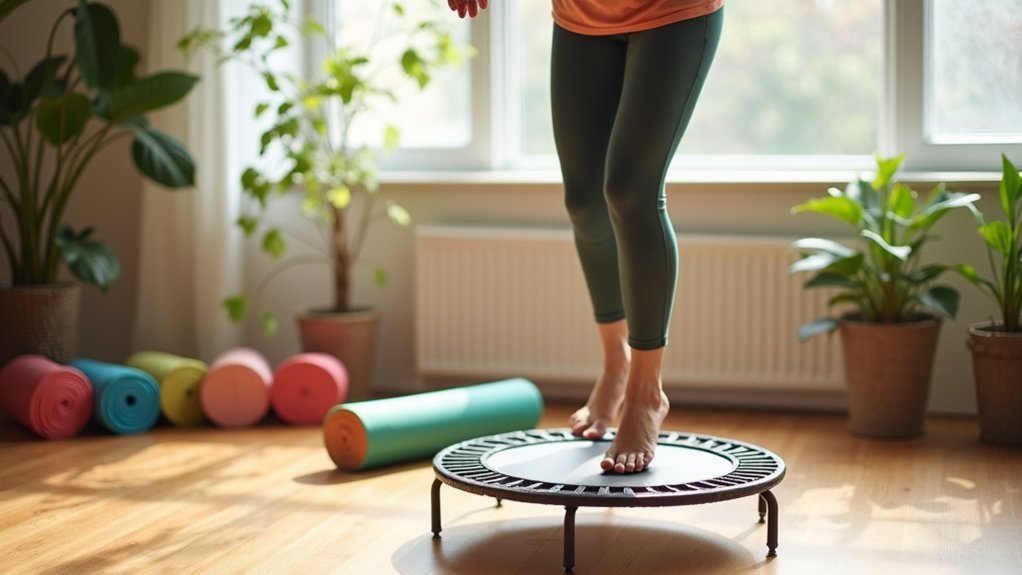
Building endurance on your mini-trampoline requires a strategic approach if you’re managing a sensitive body. Start with just 5-10 minutes of gentle bouncing or walking in place, then gradually increase your workout duration by no more than 10% weekly. This measured progression helps build endurance while respecting your body’s limits.
Begin with gentle movement and respect your body’s journey by increasing duration gradually—your endurance will build safely.
- Listen to your body’s signals – immediately decrease intensity or stop if you experience pain, honoring your current capabilities rather than pushing through discomfort.
- Mix up your movements – incorporate side-to-side hops and light jogging to engage different muscle groups while maintaining controlled motions.
- Prioritize proper support – wear supportive footwear and verify your trampoline sits on a stable surface to minimize stress on sensitive joints.
Incorporating Breathing Exercises During Gentle Rebounds
Proper breathing transforms your mini-trampoline workout from simple bouncing to a full mind-body experience. When you coordinate your breath with your movements, you’ll enhance oxygen flow and promote deeper relaxation while rebounding.
Inhale deeply through your nose as you land softly, expanding your diaphragm to engage your core. Then exhale slowly through your mouth during upward bounces, releasing tension with each rise.
| Bounce Phase | Breathing Action | Benefit |
|---|---|---|
| Landing | Inhale (nose) | Core engagement |
| Rising | Exhale (mouth) | Tension release |
| Rhythm | Count 4 in, 6 out | Steady pattern |
| Focus | Mindful attention | Stress reduction |
| Flow | Continuous cycle | Meditative state |
Try counting your breaths (four in, six out) to establish rhythm during your mini-trampoline session, turning your exercise into a meditative practice.
Creating a Sustainable Mini-Trampoline Practice for Long-Term Recovery

Beyond breath work lies the path to lasting recovery through your mini-trampoline practice. Establishing a consistent mini-trampoline training program requires patience and gradual progression. Start with 10-15 minute sessions, then slowly increase duration as your body adapts to this new fitness routine.
- Track your improvements – noting enhanced balance, endurance, and mood will fuel your motivation when challenges arise.
- Maintain variety – incorporate guided workouts or instructional videos to prevent boredom and keep your practice fresh.
- Honor your body’s needs – embrace low-impact exercises like gentle bouncing or walking in place, allowing for effective recovery without joint strain.
Frequently Asked Questions
Can You Get a Good Workout on a Mini Trampoline?
Yes, you’ll get an excellent workout on a mini trampoline. You’re engaging multiple muscle groups, burning more calories than jogging, and improving cardiovascular health—all while protecting your joints from high-impact stress.
What Is 10 Minutes on a Trampoline Equal To?
Ten minutes on a trampoline equals roughly running a mile. You’ll burn about 50 calories, boost your lymphatic circulation, and get cardiovascular benefits. It’s gentler on your joints than traditional running.
How Long Should I Jump on a Mini Trampoline to Lose Weight?
You’ll need to jump on your mini trampoline for at least 30 minutes at moderate intensity to effectively lose weight. Aim for 3-5 sessions weekly, and incorporate high-intensity intervals to maximize your calorie burn and results.
How Many Calories Do You Burn Jumping on a Mini Trampoline for 30 Minutes?
You’ll burn about 150-250 calories jumping on a mini trampoline for 30 minutes. If you weigh 125 pounds, expect to burn around 168 calories, while at 155 pounds, you’ll burn approximately 205 calories.
In Summary
You’ve now discovered why mini-trampolines are ideal for fibromyalgia management. By starting slowly, focusing on form, and listening to your body, you’ll gain strength without flare-ups. Remember, it’s not about intensity but consistency. Even five minutes daily can improve circulation and reduce pain. As you progress, you’ll notice improved balance, energy, and mood. You’re not just exercising—you’re reclaiming your body’s capabilities.
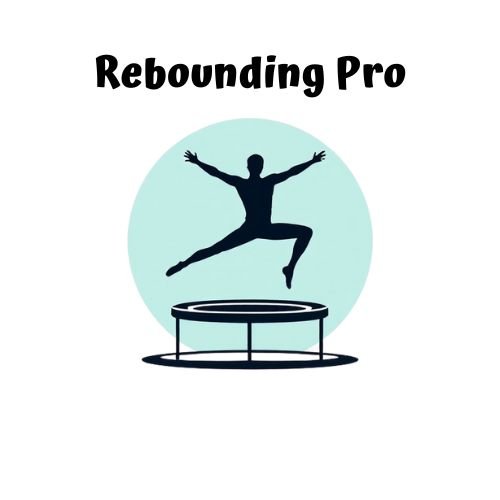
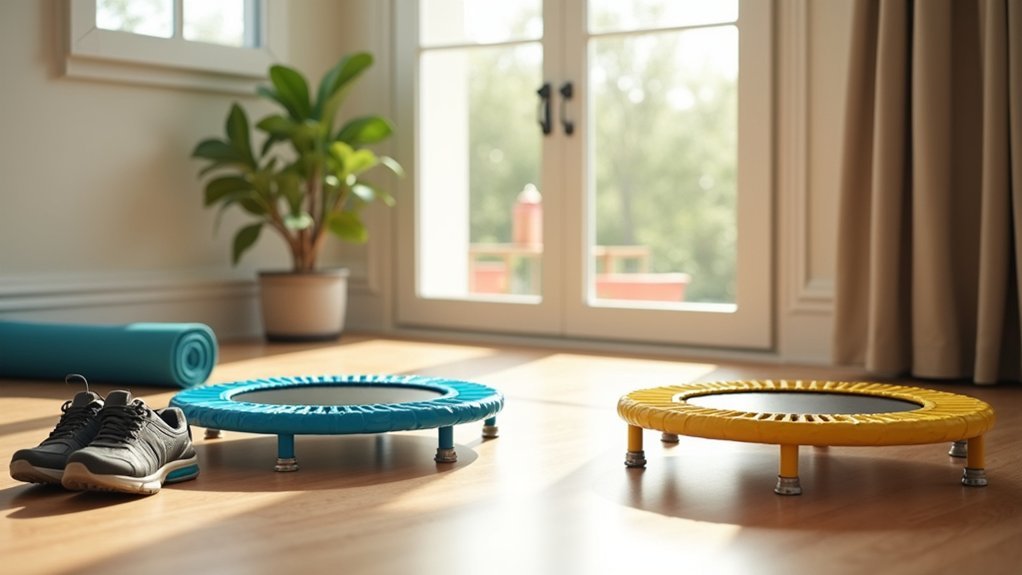


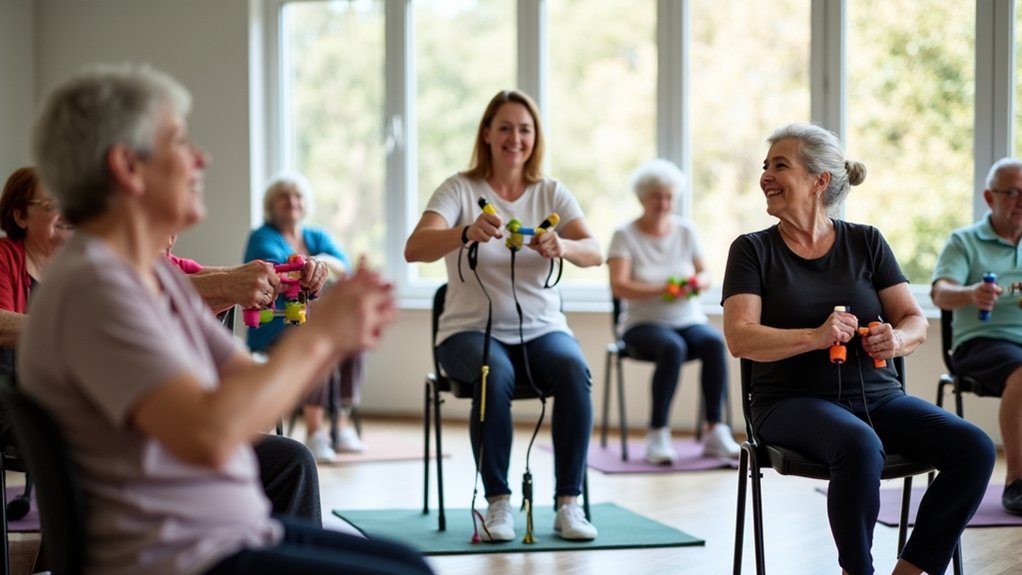
Leave a Reply